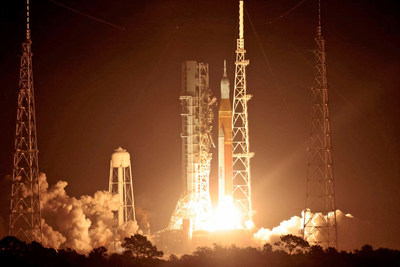Lockheed Martin-Built Orion Spacecraft Launched to the Moon on Historic Artemis I Mission
This test flight is the first in a series of missions under
Orion lifted off aboard
"We're witnessing history as Artemis I brings us one significant step closer to making
With this successful launch, the planned 25.5-day mission has begun. It will initially take several days to reach the Moon and fly above its surface. Using the Moon's gravitational force, it will propel into a unique distant retrograde orbit that will take it about 40,000 miles beyond the backside of the Moon. Orion will orbit the Moon and collect data to allow mission controllers to assess the performance of the spacecraft and its payloads.
Orion will fly close to the Moon and use a precisely timed engine firing in conjunction with the Moon's gravity to accelerate back toward Earth – traveling at 25,000 mph as it enters the planet's atmosphere. The spacecraft will splash down off the coast of
"Most people today have not lived in a time when a human-rated deep space spacecraft has gone to the Moon or beyond," said
With a focus on leaning into commercial partnerships and building innovations that will prepare the industry for a future crewed mission,
- Callisto:
Lockheed Martin partnered with Amazon and Cisco to develop Callisto, a technology demonstration payload installed inside and interfacing with Orion during the Artemis I mission. Since Artemis I is uncrewed, Callisto was designed to test and demonstrate how commercial technology could be used to support future crewed missions in space. During the mission, controllers will operate the payload from theJohnson Space Center . - LunIR CubeSat: One of 10 small satellites riding along with Artemis I, the
Lockheed Martin -funded LunIR is a technology demonstration which will take images of the Moon to test the company's ultra-compact, novel infrared sensor that maps the Moon in both day and night. The team will apply learnings from this LunIR endeavor to future lunar and planetary scouting missions to support lower cost, applicable small satellites and technology demonstrations. - AstroRad Vest: The Artemis I mission will also test AstroRad, a radiation-shielding vest developed by StemRad, a partnership between
Lockheed Martin and theIsrael Space Agency . The vest is made for space travel and is modeled after anti-radiation vests used by first responders on Earth. The MARE experiment put two torsos aboard the spacecraft – one wearing an AstroRad vest and one without to help determine exactly how much protection it will offer astronauts.
Join the Artemis and Orion journeys by downloading the Explore Orion app to your mobile device and following @LMSpace on Twitter.
Headquartered in
Please follow @LMNews on Twitter for the latest announcements and news across the corporation, @LMSpace to learn more about the latest technologies, missions and people driving the future of space.
![]() View original content to download multimedia:https://www.prnewswire.com/news-releases/
View original content to download multimedia:https://www.prnewswire.com/news-releases/
SOURCE
Gary Napier, Lockheed Martin Space (720) 224-7955; gary.p.napier@lmco.com






